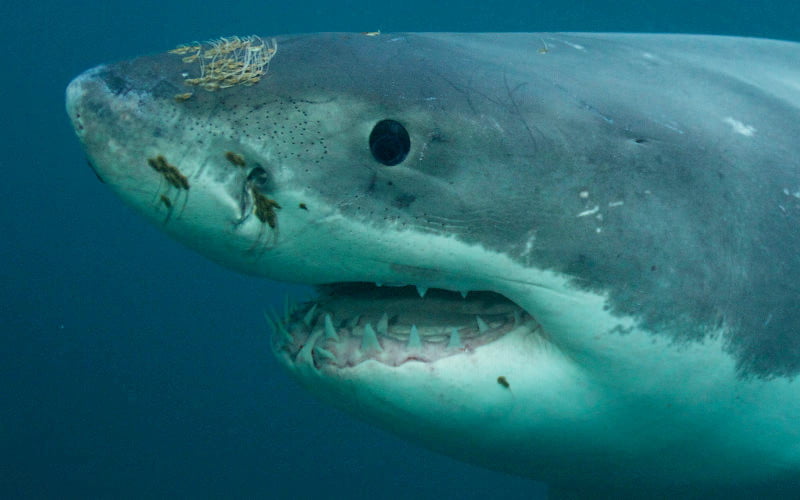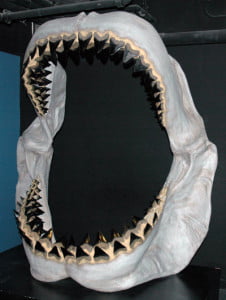
Megalodon. According to Fossilguy.com, this extinct species of shark was somewhere upwards of 50 or 60 feet long, with teeth over seven inches. They were huge monstrosities that owned the oceans during the Miocene and Pliocene epochs, until they went extinct about 2.5 million years ago.
I recommend heading over to Fossilguy.com and checking out some of their pictures; you will be surprised.
But if you thought mermaids were the only controversial currently-non-existent species roaming our oceans, you’d be wrong. Recent documentaries and alleged sightings would claim that the megalodon are not extinct. In fact, if some of what I’ve read is true, one could be standing behind you right now.
Alleged Megalodon Sightings and Hoaxes
A review of the evidence surrounding potential megalodon sightings by Ben S. Roach, titled “A Critical Evaluation of the Supposed Contemporary Existence of Carcharodon megalodon,” contains a few “eyewitness accounts” of our supposedly extinct creature.
One alleged sighting recounted by Roach is that of David Stead in 1918, near Broughton Island, an island located near Port Stephens in New South Wales, Australia. Roach quotes Stead:
“The men had been at work on the fishing grounds—which lie in deep water—when an immense shark of almost unbelievable proportions put in an appearance…the men were all unanimous that this shark was something the like of which they had never dreamed of.”
Roach shares another account from 1933, off the coast of Rangiroa in French Polynesia, when a father and son aboard the S.S. Manganui witnessed an incredible sight:
“At first I thought it was a whale, but when the great brown tail rose in the ship’s wake as the fish moved ponderously away from the liner, I knew immediately that it was a monstrous shark. The huge round head appeared to be at least 10 to 12 feet across if not more … It was my belief that this huge, yellowish, barnacled creature must have been at least 40 or 50 feet long…So what was he—perhaps a true prehistoric monster of the deep?”
Roach has his own opinions on the above two sightings, and remains unconvinced. More recent megalodon “sightings,” however, are far more dubious, like the following video from Japan:
I don’t actually know what’s going on in this video, because I don’t speak Japanese. I’d like to. But when it popped up in 2010, the claim was that scientists at the Mariana Trench were laying bait when they caught footage of what “might“ be a Megalodon.
As for hoaxes, in 2014 World News Daily Report shared a story about a “15-ton prehistoric shark” captured off the coast of Pakistan by a group of fisherman. This, as it would turn out, was not true. Not even a little bit.
The Discovery Channel Mixes Things Up… Again
But truth is a funny thing. Because sometimes it’s difficult to tell what’s true and what’s not, especially when you’re dealing with what should be a reliable source.
In 2013, The Discovery Channel aired a documentary titled Megalodon: The Monster Shark Lives during its ever-popular Shark Week.
Like another of their strange documentaries, Mermaids: The Body Found (which originally aired on Discovery’s sister channel Animal Planet), this one purportedly showed evidence of the gigantic sea creature’s modern existence, and even included a faux hunt for the beast off the coast of South Africa.
One image included in the program appeared to show a megalodon off Cape Town, South Africa on December 18, 1942, swimming amongst submarines:

The documentary – or perhaps better called docufiction – drew outrage from biologists and loyal Discovery Channel viewers alike. But as Time Magazine reported after it aired, it left many convinced that megalodon could still be alive:
“A post-show poll shows 79 percent of respondents, as of Tuesday evening. believed the megalodon is still alive after watching the documentary. Only 27 percent said they thought the shark was extinct and ‘the scientists are right.’”
It also drew in 4.8 million viewers, the largest number of any Shark Week episode ever. Which is probably why, like with their mermaid documentaries, they aired a follow-up during 2014’s Shark Week called Megalodon: The New Evidence.
In a related note, the new president of The Discovery Channel, to his credit, has recently promised to maybe not air fake documentaries on their science channels anymore.
We’ll see how that goes.
The Truth About Megalodons

Like my opinion on Bigfoot, I don’t think it’s outlandish to believe there are species that exist, especially “extinct” species, that we simply aren’t privy to. Is it possible there’s a megalodon swimming around deep beneath the ocean’s surface and we simply aren’t aware?
As unlikely as it would be, I don’t see why not.
However, given everything we currently know, it’s a fair assumption to make that the megalodon is no longer an active participant on Planet Earth. A study released just last year analyzed when Carcharocles megalodon went extinct, attempting to reach a more accurate date: 2.6 million years ago.
Have you seen a megalodon lurking about recently? Let me know in the comments. And if you’re up for more curious creature conundrums (sorry), be sure to check out the first of this 12-post series, The Mermaid Situation.



